
|   |

|   |
Amrit Yuva Kalotsav in Jammu - Tapati Chowdhurie e-mail: tapatichow@yahoo.co.in January 25, 2023 Amrit Yuva Kalotsav by Sangeet Natak Akademi is a one-of-its-kind initiative to kickstart a unique program to lead the youth of the country to set a goal for themselves and plan a career to venture into a path less trodden. To hold this kind of an all comprehensive program was the brainchild of its newly appointed chairman Dr.Sandhya Purecha. To mark 75 years of India's Independence, she has planned 75 days of presentation of the festival at various venues across the country. As the festival meanders its way through every nook and corner of the country like a river, carving new pathways, it promises to provide the actual and the virtual participants with glimpses of the existing rich culture of the place. SNA collaborated with Jammu and Kashmir Academy of Art Culture and Languages (JKAACL) and Girdhari Lal Dogra Memorial, Govt. Degree College, Hiranagar, to present mesmerizing performances by the artists of Uttar Pradesh, Jammu and Kargil. The Amrit Yuva Kalotsav in Jammu held from the 6th to 9th of January was inaugurated by the Lieutenant Governor Manoj Sinha of Jammu and Kashmir. He said that the Amrit Kaal Khand is the opportune moment to build a powerful and self-reliant India by strengthening the cultural and social unity of the country. The onus to achieve this goal and ensure the welfare of humanity rests on the shoulders of our youth. Underscoring the need to bring the young generation closer to the roots of art and cultural heritage, he opined that Amrit Yuva Kalotsav is an opportunity to look at our rich cultural legacy. India is the only country in the world, he said, which has created a balanced environment for science, art and spirituality to grow and blossom together. He observed that Art is a living element of our tradition and its different forms will play an important role in building a self-reliant India. This festival is an opportunity to see the vastness of life's values. Our collective resolve for the cultural journey of the next 25 years is to re-establish the glory of India on the world stage. Youth energy, national unity and self-reliant society will play a crucial role in realizing this resolution, he further stated. The youth according to him is the most powerful driver for change in the 21st century and they will play a crucial role in equitable development and transformation of the society. Art is a powerful instrument for social transformation. For centuries, various performing arts like Bharatanatyam, Kuchipudi, Kathak, Hindustani classical music and other genres have kept the arts alive for the future generation and have also made efforts to unite the whole country through it, he further added. The Lt Governor motivated the youth to recognize their unique potential and contribute towards nation building and to remember that the responsibility of preserving the country's cultural treasure and the spirit of Ek Bharat Shreshtha Bharat is on the shoulders of the youth. Eminent theatre personality Balwant Thakur, former minister Abdul Ghani Kohli, Avny Lavasa, Deputy Commissioner Jammu, renowned artistes and prominent citizens were present on the occasion. Dr Sandhya Purecha, Chairperson, Sangeet Natak Akademi, while speaking on the occasion highlighted the efforts of the Akademi to connect the youth with the cultural heritage. The far sightedness of the Chairman was the inclusion of a workshop on Art Critique that was organized as part of the three-day festival of music, dance and drama. This gave the youth choices in remaining in the field of art even if they did not become performers. Art criticism also enables one to become an aficionado and appreciate the great tradition of the country. Critics play a major role in art appreciation. They help one to differentiate between good and bad art. It helps one to appreciate the concept of 'unity in diversity'. The two day workshop on Art Critique was an unique feature of Amrit Yuva Kalotsav, where experts and scholars of music, dance and drama spoke of their experiences in the presence of the youth of the country, who were free to ask questions and clear their doubts and think of taking up critiquing as a profession or at least help in making them knowledgeable rasikas. Scholar and theatre person Balwant Thakur, music critic and tabla maestro Vijay Shanker Mishra, eminent editor and writer Prayag Shukla, flautist Chetan Joshi and yours truly, shared our experiences on critiquing with the youth. It was a very welcome and useful exercise. Budding artistes got a unique opportunity to interact with seniors, expert art critics and scholars on live and virtual mode. 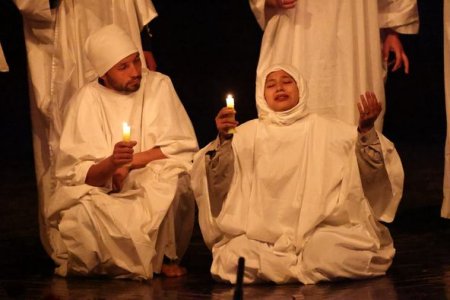 Rongkhang The festival in Jammu gave us a brief glimpse into the lives of the people of the region. We all know that art is an imitation of life. Thus did we see the Ladhaki play 'Rongkhang' directed by Kacho Ahmed Khan of Kargil spelling out the difficulties faced by the people. This was an eye opener to the audience who live in the plains. The theme revolved around the sins committed by professionals in the different fields. The venue was the imaginary gate of Hell, where the sinners await their turn to be judged by the creator. There was much food for thought in this. The play Kasak by Natrang was a tragedy that revolved around Rajanikant Patel, the protagonist who avenges the murder of his family and wrongful incarceration. It was by the young director Rahul Singh, who commended himself remarkably in portraying the character of an alcoholic in rehab and who manages to pin the culprits in his own inimitable way. 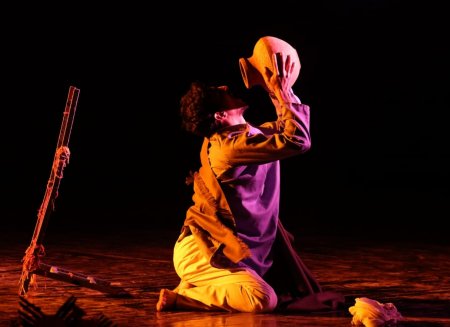 Neer Nirupam The presentation 'Neer Nirupam' directed by Saud Al Rashid Para under the banner of Grey Greed Productions, Delhi, showcased poignantly problems of water crisis. People who have never gone through this experience felt a lump in their throats, such was the power of their acting. The play was about the story of a small village in Rajasthan facing an acute water crisis. Apart from the plays the audience witnessed mesmerizing performances of Sars Bharti and group who presented Geetru Folk Music and Dance. Geetru is a form of dance and song of the Dogra Pahari region of Jammu performed on feast days, festivals and weddings where both men and women participate for the purpose of entertainment. 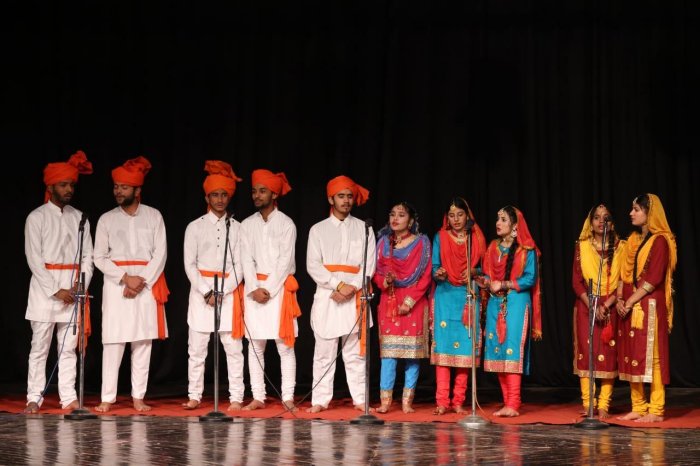 Choral music Choral Music by the students of Girdhari Lal Dogra Memorial, Govt. Degree College, Hiranagar was impressive and well-coordinated. 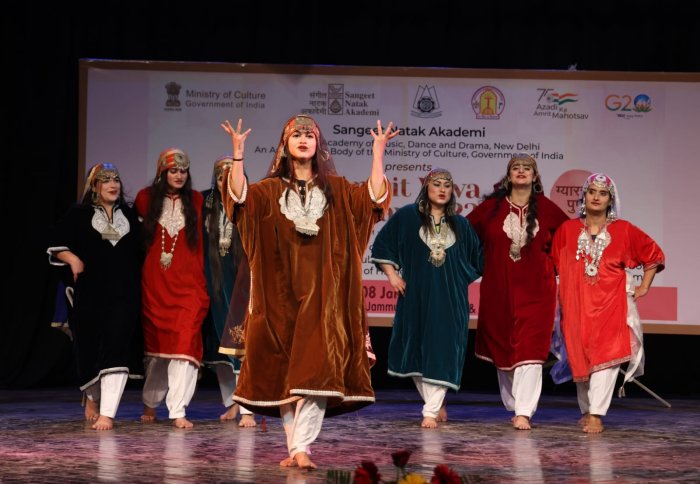 Rauf dance Sweet Screen Production from Srinagar presented Rauf dance performed by women providing the audience with a picture of the delightful performance. In spring time the Kashmir valleys are filled with colourful flowers, and the hearts of the Kashmiri people are filled with joy. Rauf dance celebrates the arrival of spring by gathering together and dancing. Women attired in salwar kameez with embroidered pherans with beautiful headscarves called kasaab or daejj adorn themselves with traditional silver jewels and form two chains of dancers facing each other. With the typical Kashmiri lyric playing in the background, they start swinging forward and backward gracefully, spreading the joy of the season. There is magic in their footwork and torso movement. The two rows interact while dancing and enjoy the rhythm of the composition. A joyous spirit is created as they welcome spring. Rauf dance is a sort of thanksgiving to nature. It's a musical gesture of gratitude for bringing the happiness of spring to the valleys of Kashmir. Rouf dance is simple. Its beat beckons you to dance in abandon. In the case of stage performances, traditional instruments such as Rabab are played in the background. Artistes from Ladakh presented the best of Yin culture. Buddhist chanting from Ladakh by monks noted for their skill in throat singing, a specialized form of chanting in which by amplifying the upper regions of the voice the chanter produces multiple and distinct pitches simultaneously. Bilal Ahmad Ganie - a regular performer of All India Radio and Doordarshan, son and disciple of Farooq Ahmad Ganie - and his team enthralled the audience with Sufiyana Kalam and its intricacies, which is one of the most popular forms of music played in Jammu and Kashmir. It has a global audience too. Also in the festival one got to see the power packed performances of Kathak by Nityanjali Society for the Promotion of Classical Dance.  Kathak Kathak performance by Vasuki Natyashala from Delhi was a noble attempt at infusing interest amongst the people of the valley with the art form. Kathakars Sreevarna Rawat, Sowmya Mittal and Garima Saldhana danced the different technical aspects of Kathak in raag Jog and Jhaptaal before performing a tarana, but they by-passed the most important role of a Kathaka, which is telling kathas or stories, which displays their talent in abhinaya. The Duggar Choir was a very good attempt in exploring the spread of Dogri culture, which go to the credit of Dr. Bharat Bhushan. The group's mellifluous singing of catchy tunes of the land was entertaining. 'Jagrani' gave us a glimpse of the indigenous culture of the place. As per tradition when the men folk accompany the groom for marriage to the bride's house, the women involve themselves in joyful chores reminiscing their own marriages with joy, while totally engaged in household duties. Dressed in bright clothes or their own wedding dress they imitate the joy of the happy occasion when they were getting married. Bipul Kumar Ray and Ritesh Prasanna cast a spell on the audience with their melodious santoor and flute duet in raag Kirwani, with Sashikant Patil on the pakhawaj and Zuber Ahmed Khan on the tabla. After a brief alaap they were able to establish the full raag, much to the enjoyment of the listeners. 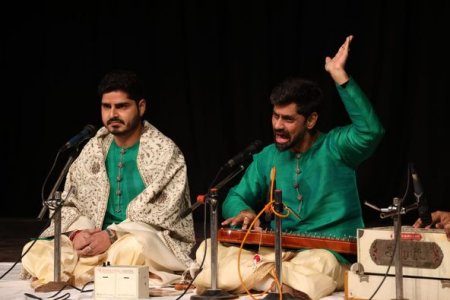 Rahul Mishra and Rohit Mishra Hindustani vocalists Rahul Mishra and Rohit Mishra of Varanasi, sons/disciples of Trilokinath Mishra and Girija Devi, sang "Govind gun gao" in raag Madhuvanti and ended with a thumri in their sweet-toned voices in Banarasi gayaki style. They were accompanied by Anshu Singh on tabla, Amish Mishra on sarangi and Sumit Mishra on harmonium. A plethora of artistes sang, danced, and enacted dramas, while people came in large numbers in spite of the spine-chilling cold, a story by itself.  Tapati Chowdhurie trained under Guru Gopinath in Madras and was briefly with International Centre for Kathakali in New Delhi. Presently, she is a freelance writer on the performing arts. |